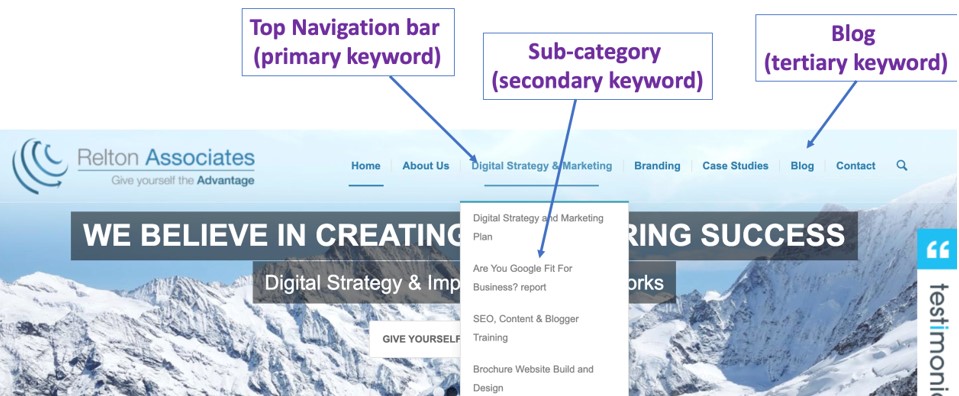Taking a business online?
Are you taking a business online?
Here are 6 steps you must complete before you build a website. Failure to follow these steps could result in your website attracting no traffic, or worse, the wrong type of traffic, delivering a very poor ROI.
- Audience Analysis
- Current audience
Look at who your current customers are, as individuals or as a type of business - Who are your 'preferred' clients?
These will be your current clients/customers who are easiest to manage and provide you with the best profit margin, rather than those who take 80% of your time for only 20% of your revenue. Focus on this audience base first. - Define your clients/customers
Things you would look for are things like...
-Age group
-Gender
-Ethnic background
-Their values (i.e. dietary, spiritual/religious, etc)
-Location (Town, City, Country, etc)
-Industry/profession and perhaps job title
-How did they find you? - i.e via what channel?
-What are their interests? - e.g. media do they read? where do they train (CPD points, professional)? what are their pain points/issues? how much do they earn and any other criteria you feel could be relevant?
This list will vary depending on what industry you are in and what your client/customer offering is. - Business
As well as the above, you could also look at your customers as a business by looking at things like...
-number of employees
-turnover
-industry vertical
-the decision makers by job title/position
-company Key Performance Indicator’s (KPIs)
-industry media
-industry training
-look at whether they are 'innovators' in their field
-consider what their brand mission, vision and values are - Where do you find this audience analysis information?
Much will be what is considered to be 'marketing intelligence', you just 'happen to know' but have never truly considered in your work before, or formalised into profiles.
However, this should be as data-driven as possible so here are some places you can go to find the information:
-Companies House https://www.gov.uk/government/organisations/companies-house
-LinkedIn https://business.linkedin.com/marketing-solutions/reporting-analytics
-Google Analytics for your business (if you have it set up and you should) https://analytics.google.com/analytics/web/provision/#/provision
-Google Adwords for your business https://ads.google.com/intl/en_gb/getstarted/
-Social media reporting tools on your business accounts (i.e. Facebook) - these all sit within the specific social media platform, or, if you have a social media management tool such as Hootsuite, this will also show you a range of data and analytics
-Ask your clients directly - perhaps with the use of a survey (don't make it too long)
-Team brainstorming (focus groups)
-Products/services already sold

- Target Audience Analysis
Very similar to the above Audience Analysis but, there is often a disconnect between your ‘current’ clients and you ‘desired’ clients. Your Target Audience is, therefore, the clients you want to have and not necessarily who you already have. For example; you may be attracting clients or business that just can’t afford your services and you need to acknowledge these differences so you can adjust your messaging and media.
- Persona Generation
Once you have completed the Audience and Target Audience Analysis you can then generate personas. Typically, you would have 2-6 personas. A persona is a ‘type’ of person/business.
To create a persona, you will need to group your already defined audience (from your audience analysis) into persona types. Group them by what they have in common. It is not always the statistical data that you would group by (i.e. mothers aged 30-40 years old) but often by the reasons they came to you over others (i.e. you offer 24/7 IT support so they don’t have to ‘worry about it’ not working).
Here are some basic examples:
Andy Athlete (persona 1)
- Competes in competition
- Highly focused on a training & nutrition regime
- Trains 5 times a week
- Typically aged 25-50
- Predominantly male
- Focuses on recovery, endurance & strength products
Blood Pressure Brian (persona 2)
- Told by Dr to do some exercise
- Tries to go exercise x3 a week
- Suffers from High Blood pressure / Cholesterol / Overweight
- Typically aged 40+. Male or Female
- Focuses on fat loss products
- Buys vitamins & minerals to help their immune system/health
- Target Keyword Analysis
Now you know who you are targeting you can determine how they will go about finding you online. What words will they type into search engines like Google to find your business? There are various ways you can ascertain strong keywords, here’s a few:
- Market Intelligence – again your own industry knowledge will enable you to draft a list of keywords
- Ask your clients/businesses – ask them how they would go about finding you and your services
- Competitor’s marketing - Run an analysis on your competitors Google Adwords campaign to see what is working for them in driving traffic to their website
- Competitors website - Run an analysis on your competitor’s websites to see how they get their organic search traffic
- Target Keyword refinement
Now you know your keywords, you can start to determine which are the primary keywords. Which keywords are likely to send you the highest amount of traffic and more importantly the right type/quality of traffic. Creating a list of primary, secondary and tertiary keywords will enable you to prioritise your website content when you create your sitemap. - Preparing for your website build
Create a website 'Site Map'
- A sitemap is quite literally that, a map of your website and how your visitor will find things. Companies like Relton Associates do these using an excel sheet, but in the image below you can see an image of a live sitemap.
- Primary Keywords tend to make up the top navigation bar. Secondary keywords tend to make up the top navigation sub-categories and the tertiary keywords tend to make up the blog content (and will support primary and secondary keywords). It’s not always this way as every business and website is different.

- Now you are in a position to request quotes for building a website. Web developers will base a price on a few things: Number of pages, number of ‘designed’ pages and any other more bespoke requests.
- Ideally, you will create a brief, which encompasses the above information as well as key information such as your company’s core values and vision. Companies like Relton Associates can help you to create this, to ensure you get the best out of your website build.
- You must also ensure you let the other suppliers know you’re getting three quotes, this will ensure you get sensible pricing and offers transparency. More importantly, be wary of the agency that doesn’t give you any detail and promises the earth. A good website will attract traffic if you go through the above 6 steps but even then, you will need to do some marketing. You won’t be the only person in your field turning to online.
- It's also a good idea to ask them for references and see examples of their work - remember you are employing them, so you can treat it a little like an interview process.
- The suppliers may all use various website building platforms so it's an idea to do some research around these too so you can narrow suppliers by the platform they use. That's why you must make sure you choose a good Content Management System/platform (CMS) for your website.
You can read this article to help give you an idea: https://www.reltonassociates.co.uk/best-e-commerce-platforms-web-shop
This article was written by Relton Associates - website: https://www.reltonassociates.co.uk/
Wenta is an impartial publisher of this content. Please choose any and all of your suppliers based on your own research and findings.
Access Wenta's FREE support and advice, related to this subject, by using the links below: - Book onto our webinar 'Website Development For Your Small Business' here.
- Book a business advice appointment here.
Sign up for our mailing list here.
Grants. Finance. Free advice and training + more delivered to your inbox.
Sign up to receive email updates on our free training webinars, workshops, business advice programmes, affordable workspace and news.


